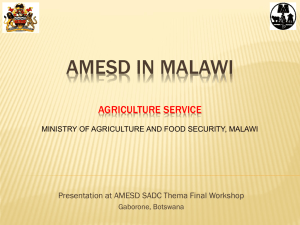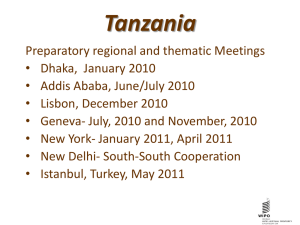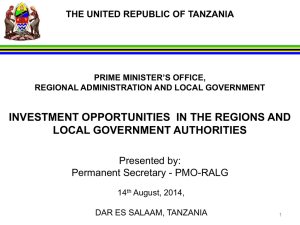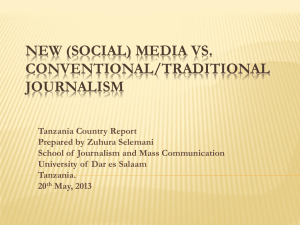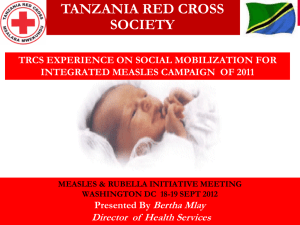Tanzania-use-of-AMESD-products
advertisement
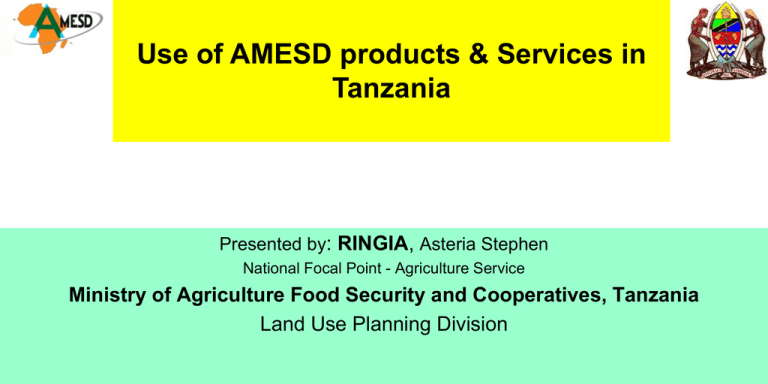
Use of AMESD products & Services in Tanzania Presented by: RINGIA, Asteria Stephen National Focal Point - Agriculture Service Ministry of Agriculture Food Security and Cooperatives, Tanzania Land Use Planning Division Presentation Outlines • Agriculture Service in Tanzania • Exploring of AMESD SADC product by Environment Monitoring and Mapping for Africa (EMMA) • Online Climatic Data Retrieval • Tanzania AMESD National Training Workshop • Challenges Agriculture Service in Tanzania • Tanzania covers 94.5 million ha of land, of which 44 million ha are suitable for crop production, and out of it only 10.1 million ha (23%) are under cultivation; and 60 million ha are classified for livestock while only 26 million ha (43.3%) are currently utilized. • The country is endowed with a wide diverse of natural resources, which include forests, wildlife, minerals, rivers, lakes, wetlands and ocean • The country has high agro ecological variability which dictates the types of agricultural activities/enterprises and the AMESD SADC products is necessary for monitoring different areas. Tanzania Agro-ecological Zones Enjoy AMESD SADC product from www.amesd.co.bw/emm >>www.amesdsadc.org/emm >>EMMA-BDMS In the middle February the rainfall is low and vegetation cover is low; in the first ten days of March 2012 the rainfall increased as well as vegetation cover but 2005 rainfall vegetation decreased and in the end of April, 2012 rainfall increases further and also the vegetation cover but 2005 rainfall and vegetation decreases The Vegetation Productivity Indicator is used to qualitatively identify areas with below normal vegetation development possibly linked to low agricultural productivity and to identify drought affected areas. The VPI percentages indicate the probability of getting a lower NDVI values based on historical analysis of the NDVI values. A probability of 20% indicates that there is a 20% chance of getting a lower value and thus 80% chance of getting a higher value compared to the previous year for the given date. The Normalized Difference Vegetation Index (NDVI) which can be used to measure and monitor plant growth, vegetation cover and biomass production. The value varies between -1 to 1; increasing positive NDVI value indicates increase amounts of green vegetation. Moderate values represent shrubs and grassland (0.2-0.3); while high value indicates temperate and tropical rainforests (0.6 to 0.8). From the maps the areas where VPI (indicator) percentage increases also the NDVI (Vegetation) increases The Tanzania Season (2011) Compare it with Season (2005) Singida From the graph, the season 2005 vegetation cover is low than season 2011 and also the vegetation cover is below average Tanzania Outlook For the Current Season The graph shows NDVI LTA Max, LTA Min and Filtered NDVI; -and also the current season of rainfall for 2011/2012 and LTA of rainfall. In this case the Outlook for the current season could be above normal rains throughout the year, good harvest could be expected if other agronomic factors remain constant Comparison of Current and Anomaly of vegetation and rainfall (Anomaly= Current map – Long-term Average map) Current and Anomaly Vegetation Tanzania maps (20110421) Current and Anomaly rainfall Tanzania maps (20110421 Enjoy In Situ and Online Data Retrieval Using Integrated Land and Water Information System (ILWIS) a Free User-Friendly Software Exploring the internet resources using the ISOD Toolbox Different Meteorological stations allover the world Boundaries of different countries showing Meteorological stations Zooming to the Area of Interest, Tanzania View the Various information from ISOD Temperature and Rainfall derived from Mwanza Meteorological station, Tanzania (2009) Tanzania AMESD National Training Workshop AMESD National Training workshop 2011 AMESD National Training workshop 2012 Monitoring of Agriculture with Remote Sensing Bulletin Created by Participants of AMESD Tanzania National Training Challenges • The E-station is not operational, it was installed since 9th April 2011 and on17th April 2011 the problem started and the case was reported to the AMESD SADC and Telespazio. The initiatives taken in the first step were the replacement of motherboard (two times) of acquisition machine, UPS, and DVB card by Telespazio; in spite of all that efforts applied, yet no improvement has been realized up to this moment. • Lack of funds for training more people on the use of AMESD SADC products, purchasing Computer Laptops and for the system maintenance. • The funds for national training to pay the perdiem for participants outside from the city is not sufficient Thank you Asante Sana
